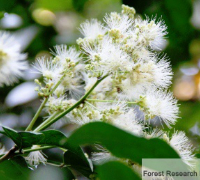Pithecellobium bubalinum: Kerdas, the local appetizer

Kerdas or Pithecellobium bubalinum is a large, shady tree that belongs to the family Fabaceae. This tree usually grows wild in the forest and can be up to 25 m tall. In some areas in Malaysia, Pithecellobium bubalinum is also known as genuak. Originating from Malaysia and Indonesia, kerdas tree grows in the tropics especially in Southeast Asia.
Kerdas wood has a hard bark, gray-brown in colour and can be used as firewood. The wood is also processed for other uses. The leaves are soft-textured and green when old while the young shoots are purple. The flowers of kerdas are borne in huge panicles, 1–2 cm long, creamy yellow in colour. The flower smells quite fragrant and attracts insects for pollination. Being light in weight, the flowers are easily dispersed by wind.
Kerdas fruits appear in a pod, green when young and will change to dark brown when fully ripe. Kerdas’ pod is tough and hard, 6–10 cm long and 2–3 cm in girth, and shaped like elongated green pea pods. When opened it contained a few seeds arranged neatly, with size varying between 10 mm–15 mm and covered by a thin layer of skin. The seed is light green, the skin is pale yellow skin when young but turns black when ripe. Kerdas fruit is edible and is often used as a side dish, but it is less popular among young people because of the strong smell that resembles Pithecellobium jiringa (jering). For villagers, kerdas fruit can be an appetizer.
Flowering kerdas tree can be seen at Bukit Hari, FRIM starting from the middle of February 2014.
Article by Naimah CL, uploaded on 27 Februari 2014. The weekly weather was cloudy, 24°C to 35°C.












